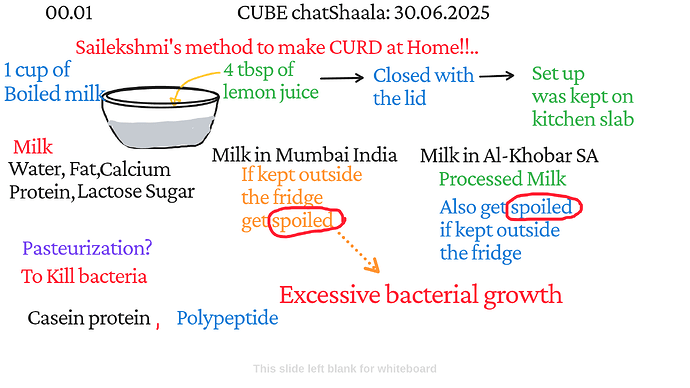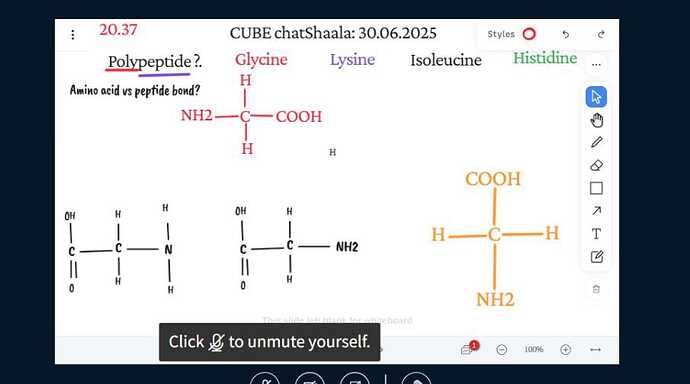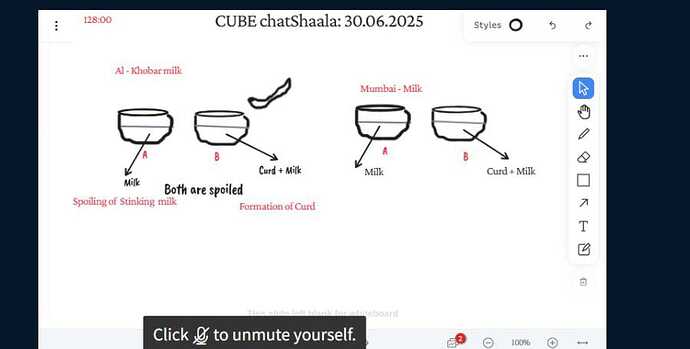@Arunan @KiranKalakotiR @Theertha @2020ugchsncnseethala @sakshiconsultant2002 @akanksha and others
Topic : Exploring Milk Spoilage, Curd Formation & the Biochemistry of Polypeptides
The session opened with Sailekshmi’s home-based curd preparation method, which sparked an exciting exploration into everyday biological processes. Her method involved mixing 1 cup of boiled milk with 4 tablespoons of lemon juice, closing the container, and placing it on the kitchen slab for natural fermentation.
This led to comparative insights between milk spoilage in different geographic contexts:
In Mumbai (India): Boiled milk left outside the fridge spoils due to bacterial growth.
In Al-Khobar (Saudi Arabia): Even processed milk spoils if unrefrigerated—indicating that pasteurization delays but doesn’t eliminate spoilage, especially under high-temperature conditions.
The group discussed pasteurization as a technique that reduces microbial load but doesn’t sterilize the milk entirely. Once exposed to ambient temperatures, excessive bacterial growth resumes, resulting in either stinking spoilage or curd formation—depending on the presence of starter culture like lemon juice or curd.
This discussion raised important questions:
-
What differentiates controlled fermentation (curd) from uncontrolled spoilage (souring/stinking)?
-
How does the microbial ecology of a region influence curd formation?
-
What role do environmental factors like temperature and local microbial flora play in determining the outcome of milk kept outside?
![]() Scientific Concept Explored:
Scientific Concept Explored:
![]()
![]() Biochemistry Deep-Dive: What is a Polypeptide?
Biochemistry Deep-Dive: What is a Polypeptide?
In the later part of the session, the discussion moved into biochemistry, specifically around polypeptides—key structural units in proteins such as casein, the major milk protein.
➤ Definition:
A polypeptide is a long, continuous, and unbranched chain of amino acids linked by peptide bonds. When two or more amino acids bond through a dehydration reaction, a peptide bond forms between the carboxyl group (–COOH) of one amino acid and the amino group (–NH₂) of another.
➤ Basic Structure of a Peptide Bond:
H O H
| || |
H–N–C–C– + H–N–C–COOH →
| → Peptide Bond + H₂O
➤ Examples of Amino Acids Involved:
Glycine: NH₂–CH₂–COOH
Lysine: H₂N–(CH₂)₄–CH(NH₂)–COOH
Isoleucine: (CH₃)–CH₂–CH(CH₃)–CH(NH₂)–COOH
Histidine: A basic amino acid with an imidazole ring (–C₃H₃N₂)
These amino acids can form linear or folded polypeptides, which then form functional proteins such as enzymes or structural proteins like casein, responsible for the thickening of milk during curd formation.
![]() Follow-Up Questions Based on Today’s Whiteboard:
Follow-Up Questions Based on Today’s Whiteboard:
-
How does lemon juice (acid) facilitate the curdling of milk at the molecular level?
-
What are the differences between spoilage and fermentation in terms of bacterial action?
-
Why does processed milk still spoil without refrigeration, even after pasteurization?
-
Can we isolate and culture the bacteria from spoiled milk to study its characteristics?
-
How does casein protein breakdown relate to taste and texture changes in curd?
-
Could different curdling agents (e.g., vinegar, tamarind) affect the peptide chains differently?
-
Why does adding lemon juice (acid) to milk initiate curd formation, and how does it affect casein micelles?
-
Is there a difference in the type of bacteria that causes spoilage vs. curd formation?
-
Can we isolate casein protein from curd and test its protein nature using biuret or ninhydrin tests?
-
How do amino acid sequences determine the final function of a milk protein like casein?
-
Could processed milk in Al-Khobar be ultra-pasteurized, and does that affect the success of curd formation?
![]() Reference
Reference


